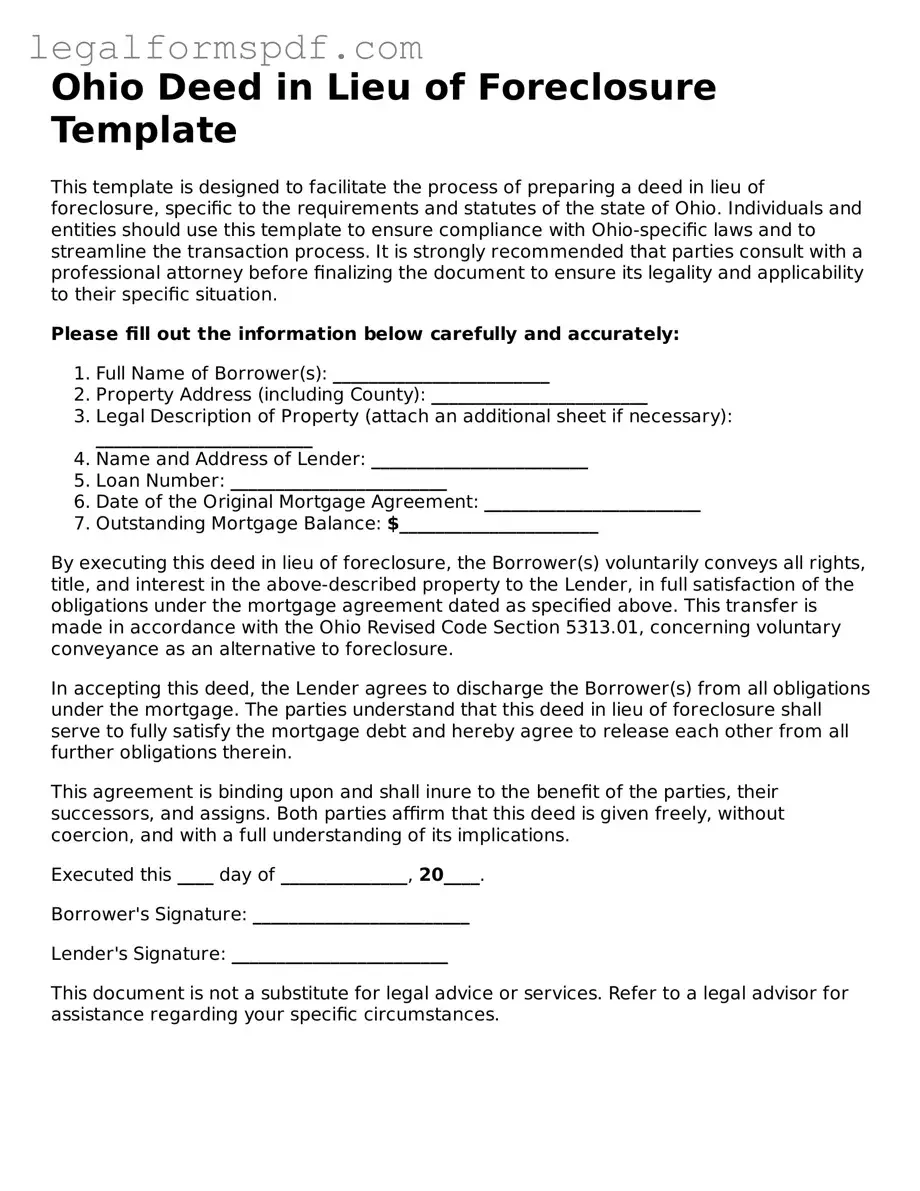What is a Deed in Lieu of Foreclosure?
A Deed in Lieu of Foreclosure is a legal document in which a homeowner voluntarily transfers the ownership of their property to the lender. This is done to avoid the foreclosure process when the homeowner can no longer make mortgage payments. It's a mutual agreement between the borrower and the lender that can benefit both parties by simplifying the process and minimizing additional costs and negative impacts on credit scores.
How does a Deed in Lieu of Foreclosure work in Ohio?
In Ohio, the process begins when both the borrower and the lender agree that a Deed in Lieu of Foreclosure is the best course of action. The homeowner then signs legal documents transferring the property's title to the lender. This action satisfies the mortgage debt, avoiding the need for a foreclosure. The lender may choose to forgive any remaining debt, although this is not guaranteed and could have tax implications for the borrower.
What are the benefits of choosing a Deed in Lieu of Foreclosure?
Choosing a Deed in Lieu of Foreclosure offers several benefits including avoiding the lengthy and stressful process of foreclosure, potentially reducing or eliminating remaining debt on the mortgage, and having a lesser negative impact on the homeowner's credit score compared to a foreclosure. It can also benefit the lender by saving time and reducing the costs associated with the foreclosure process.
Are there any downsides to a Deed in Lieu of Foreclosure?
While a Deed in Lieu of Foreclosure can provide relief in difficult circumstances, there are potential downsides. These include possible tax implications from forgiven debt, which could be considered taxable income. Additionally, it may not fully absolve the borrower of all financial obligations if there are any junior liens on the property, and it still negatively impacts the borrower's credit, though generally less severely than a foreclosure.
Who is eligible for a Deed in Lieu of Foreclosure in Ohio?
Eligibility for a Deed in Lieu of Foreclosure in Ohio typically requires that the homeowner is experiencing financial hardship that prevents them from making mortgage payments, has unsuccessfully tried to sell the property at fair market value, and has no other liens against the property. Each lender may have additional requirements, making it important for homeowners to discuss their individual situation with their lender.
What is the process to apply for a Deed in Lieu of Foreclosure in Ohio?
The first step is contacting the lender to discuss potential hardship options. If a Deed in Lieu of Foreclosure is considered a viable solution, the homeowner will need to provide documentation to the lender showing their financial situation and inability to continue making payments. This includes a hardship letter, proof of income, and other financial statements. The lender will assess the situation and, if they agree, will provide the necessary paperwork to transfer the property ownership.
Can a Deed in Lieu of Foreclosure be reversed in Ohio?
Once a Deed in Lieu of Foreclosure has been completed and the property ownership has been transferred to the lender, the process cannot typically be reversed. Due to the finality of this action, it is essential for homeowners to thoroughly understand the implications and ensure it is the best decision for their circumstances before proceeding.
How does a Deed in Lieu of Foreclosure affect my credit score?
A Deed in Lieu of Foreclosure does negatively affect your credit score, but generally not as severely as a foreclosure. It will remain on your credit report for up to seven years. The impact on your credit score can vary depending on your overall credit history and the scoring model being used, but it's important to plan for a significant impact in the short term.
Is it possible to owe money after a Deed in Lieu of Foreclosure?
Yes, it's possible to owe money after a Deed in Lieu of Foreclosure if the amount forgiven by the lender is less than the total debt owed on the mortgage. This is known as a deficiency balance. Ohio law determines whether lenders can seek a deficiency judgment, which would require the borrower to pay the remaining debt. Borrowers should carefully review their agreement with the lender to understand their financial obligations fully.
Where can I get help with a Deed in Lieu of Foreclosure in Ohio?
It's advisable to seek guidance from a legal professional experienced in Ohio real estate law to navigate the process of a Deed in Lieu of Foreclosure successfully. Additionally, housing counseling agencies approved by the U.S. Department of Housing and Urban Development (HUD) can offer valuable advice and support to homeowners exploring their options to avoid foreclosure.
